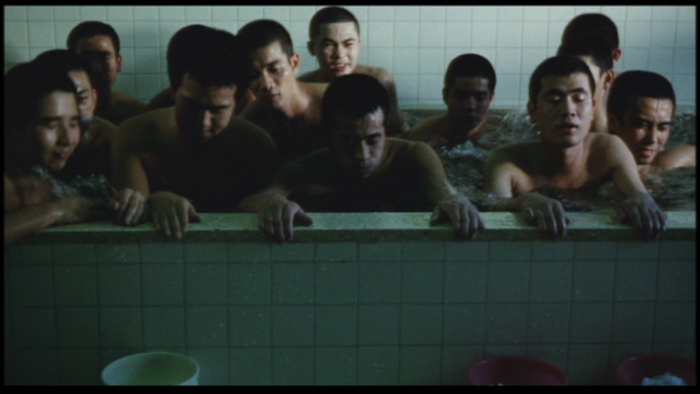THIRD (Yoichi Higashi, 1978) – Screenplay by Shuji Terayama,
The camera looks through the bars of the Young Offenders’ Reformatory.
It’s early morning. As the inmates swab the corridor floors and clean the lavatories, subtitles state their nicknames and their crimes,.
Takeo Hirai, “Deaf And Dumb”, Rape.
Toshimitsu Nakazawa, “Mr. Poetry”, Shoplifting.
Tetsutomi Shinobu, “Little Finger”, Assault.
Keijiro Matsuda, “The Flier”, Robbery with Violence.
Kiyoshi Kanazawa, “Objection”, Extortion with Threats.
Shinji Seno, “Third”, Murder.
If this were a Hollywood film, we would be in for a tale of brutal warders, miscarriages of justice and daring escape plans. But this forgotten masterpiece of the 1970s was produced by ATG (Art Theatre Guild), an independent outfit that launched Terayama’s own films, as well as many innovative works by other major directors. A Japanese Shawshank Redemption was never on the cards.
The original novel, September Town, was written by Haku Kenjo, who had experience of working as an instructor in a reformatory. Terayama’s script is a very free adaptation, but the basic outline remains. Sympathy for the inmates, none of whom are innocent. Sympathy for the staff, who are doing their best to rehabilitate their young charges and teach them trades.
Even the thuggish Akira, who laces the newly arrived Third’s miso soup with snot and phlegm, struggles hard to control his malevolent impulses. By the time of his release, he seems to have succeeded.
Third, so called because he played at third base in his high-school baseball team, is not a bad kid, though he is responsible for killing a man. His household, like Terayama’s, is fatherless. His mother is a well-meaning woman who visits him at the reformatory when she can.
Like the other inmates’ mothers, she blames her son’s fate on the “bad influence” of his friends. But his friends are ordinary too. Two naïve girls and a sensitive, intelligent boy, they dream of getting out of the dull, lifeless town they inhabit. For that, though, they need money. How can they earn enough money? The girls suggest a solution. “We’ll sell our bodies,” they say brightly.
And so begins Third’s short and disastrous career as a pimp. Boredom, loneliness, thoughtlessness, the insecurity of adolescence, sheer bad luck – all combine to seal his fate.
So far, so realistic. Indeed, the filming took place in a real reformatory and some of the inmates, parents and instructors appear as extras. The documentary style is reminiscent of the similarly sympathetic portrait of teenage delinquents in Bad Boys (1964). That film was directed by Susumu Hani, with whom Terayama collaborated on First Love: the Hell Version (1969).
There is also obvious influence from another drama set in a reformatory, Tony Richardson’s The Loneliness of the Long Distance Runner (1962, distributed in Japan by ATG in 1964). In Terayama’s screenplay, but not used in the film, is a scene in which Third lies on the grass reading the Alan Sillitoe novel on which it is based.
Like the hero of that story, Third is a natural runner. He runs not to reach home base – that no longer exists for him – nor to get to any particular destination. He runs for the sake of it. While he is in motion, he is free.
As Director Yoichi Higashi emphasizes in the informative 60 page pamphlet issued on the film’s release, Terayama’s contribution is described as an “original screenplay” rather than an “adaptation”, as is usually the case when a novel is filmed. He gave Terayama three instructions –
1. Don’t pay any heed to screenplays of previous films
2. Try to maximize the creativity of the film-makers
3. Think of the original novel and the film-makers’ ideas as mere hints
By no means all of Terayama’s ideas made into the completed film – the gay inmate was cut out completely – but plenty of his characteristic themes remain. The mother-son relationship which veers from conflict to erotic tension; the need to escape the stultifying hometown and create an independent identity. The boredom of the farmer’s routine set against the excitement of boats and the sea.
Terayama even puts himself into the film. ”Mr. Poetry” specializes in tanka verse, the thousand year old form for which Terayama first became famous. Such is the young offender’s natural talent, that he can compose a tanka with a perfect 5/7/5/7/7 syllabic count just seconds after masturbating or defecating.
In an ending that was not used, the inmates fantasize about their future selves. The bully Akira becomes a folk singer. Third just keeps running. The poetry-spouting shoplifter publishes a book of tanka that wins him widespread praise – just as Terayama himself did at the age of twenty two.
The haunting film score – with its drones and tense, heartbeat-like pulse – also comes from Terayama’s world. The composer is Michi Tanaka, Terayama’s secretary, manager and partner after his divorce.
Originally a member of Tenjo Sajiki, Terayama’s avant garde theatre troupe, she is best known for coming up with the music to accompany Terayama’s lyrics for Toki niwa haha ga nai ko no yo ni (“Sometimes I feel Like a Motherless Child”). That song became a million-seller for Carmen Maki in 1969 and has, presumably, generated a healthy stream of royalties for the composer of the music.
Third was the last screenplay that Terayama wrote for a film that he did not direct. In format and style, it is characteristically idiosyncratic. His contribution takes the film beyond the realm of social issues and into a stranger, deeper reality that lingers in the memory.

